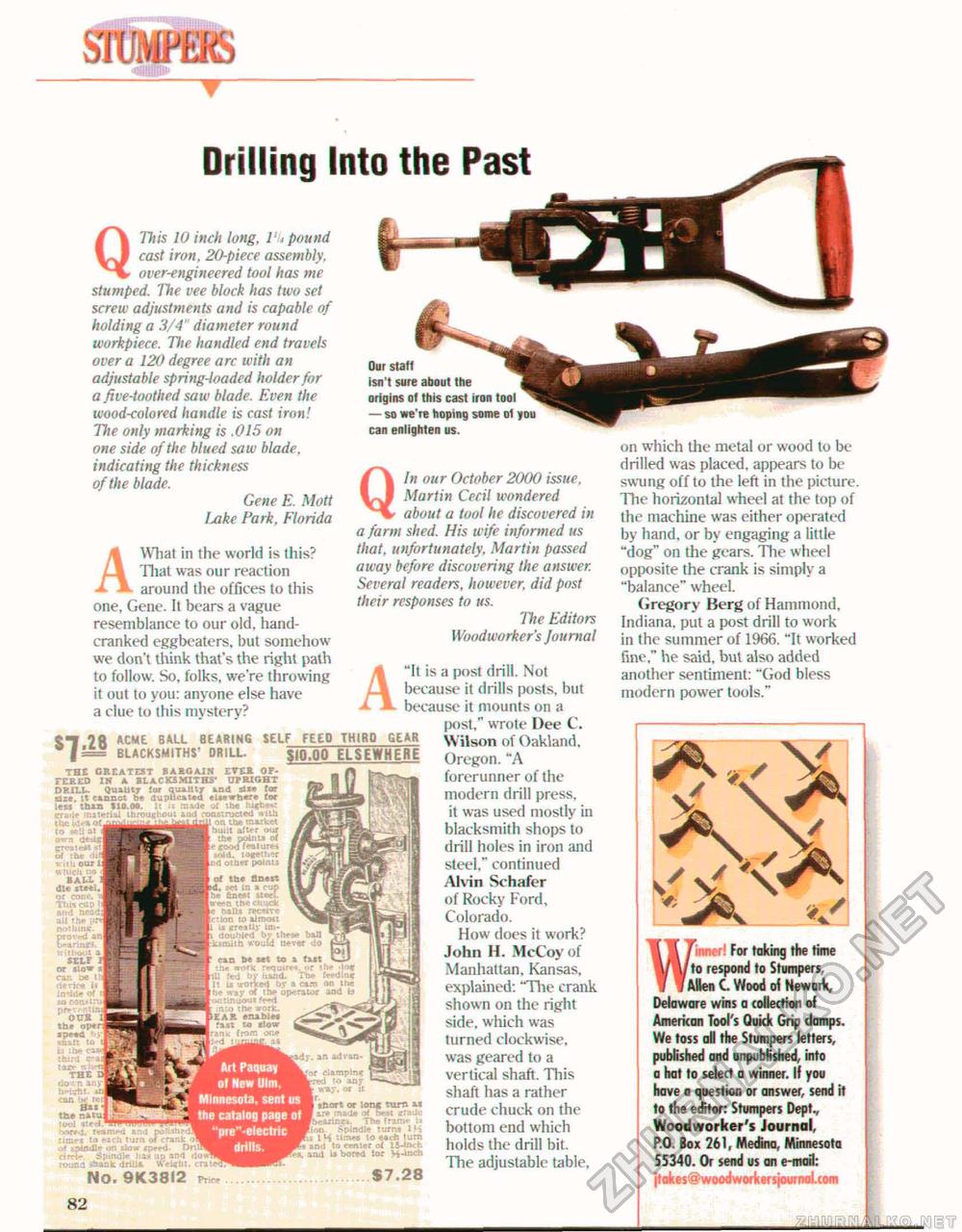Woodworker's Journal 2001-25-1, страница 82
Drilling Into the Past QThis 10 inch long, 1' j pound cast iron, 20-piece assembly, over-engineered tool has me stumped. The vee block has two set screw adjustments and is capable of holding a 3/4" diameter round workpiece. The handled end travels over a 120 degree arc with an adjustable spring-loaded holder for a five-toothed saw blade. Even the wood-colored handle is cast iron! The only marking is .015 on one side of the blued saw blade, indicating the thickness of the blade, Gene E. Mott Ixikc Park, Florida It What in the world is this? L That was our reaction around the offices to this one. Gene. It bears a vague resemblance to our old, hand-cranked eggbeaters, but somehow we don't think that's the right path to follow. So, folks, we're throwing it out to you: anyone else have a clue to this mystery? Our staff isn't sure about the origins of this cast iron tool — so we're hoping some oi *ou can enlighten us. Q f.2B ACME BULL BEARING BLACKSMITHS' DRILL. SELF FEED THIRD GEAR THE GREATEST BARGAIN EYE4 OF-rtacD IM A BLACKSMITHS' UPRIGHT DRILL- Quint; for quality and Hit tor me. It cannot be duplicated eUewtiere tor less man 110.00. II U nivle oi tin Erratic maiertai throughout and rptis'.ruciej wfla - ------ an the market built atter qui thf polfils of e good features kH<i. together rt other polnu SIO.QO ELSEWHERE the finesses In a eup Sneit itwl-_en the enuefc halls rrceive Irjion to almost ■1 It patty tin- Bi doubled b? these -j; - r an be let to a tut '.he require*, or the ■B-.;; fed Ijf hand- rv (eetliu* ■ it ii trorVcd br a cam on Hie B>i> «-!>■ ot the operator and M ^^^ f-ntlnuoiH re*it into t tie work. L A ft enable* •ait to alow irwi* from one to each turn of crnrtk if on slflw apeed ctrH-. Spindle Mas up and - .....- tfi cuuna SSaafc drtlia weight, crat _ No. 9K38I2 Pnee.............................$7.28 82 In our October 2000 issue. Martin Cecil wondered about a tool he discovered in a farm shed. His wife informed us that, unfortunately. Martin passed away before discovering the answer. Several readers, however, did post their responses to us. The Editors Woodworker's Journal "It is a post drill. Not because it drills posts, but because it mounts on a post," wrote Dee C. Wilson of Oakland. Oregon. "A forerunner of the modern drill press, it was used mostly in blacksmith shops to drill holes in iron and steel." continued Alvin Sehafer of Rocky Ford, Colorado. How does it work? John H. McCoy of Manhattan, Kansas, explained: "The crank shown on the right side, which was turned clockwise, was geared to a vertical shaft. This shaft has a rather crude chuck on the bottom end which holds the drill bit. The adjustable table. l iBort or long turn a* I are made ot best rnid<j 'beiriiviti. The franw ■i-mi Spindle turns 1J: s 1 u : L'lr- to each turn i and to center ot ISJnt-h , ami U bonea !or on which the metal or wood to be drilled was placed, appears to be swung off lo the left in the picture. The horizontal wheel at the top of the machine was either operated by hand, or by engaging a little "dog" on the gears. The wheel opposite the crank is simply a "balance" wheel. Gregory Berg of Hammond. Indiana, put a post drill to work in the summer of 1966. "It worked fine," he said, but also added another sentiment: "God bless modern power tools." \ \[ For taking the lime \! \ ho respond to Stumpers, I / Allen C. Wood of Newark, Delaware wins a collection of American Tool's Qukk Grip damps. We toss all the Stumpers letters, published and unpublished, into a hat to select a winner. Il you have a question or answer, send it to the editor: Stumpers Dept., Woodworker's Journal, P.O. Box 261, Medina, Minnesota 55340. Or send us an e-mail: jtakes®woodwork ersjownal.com |








